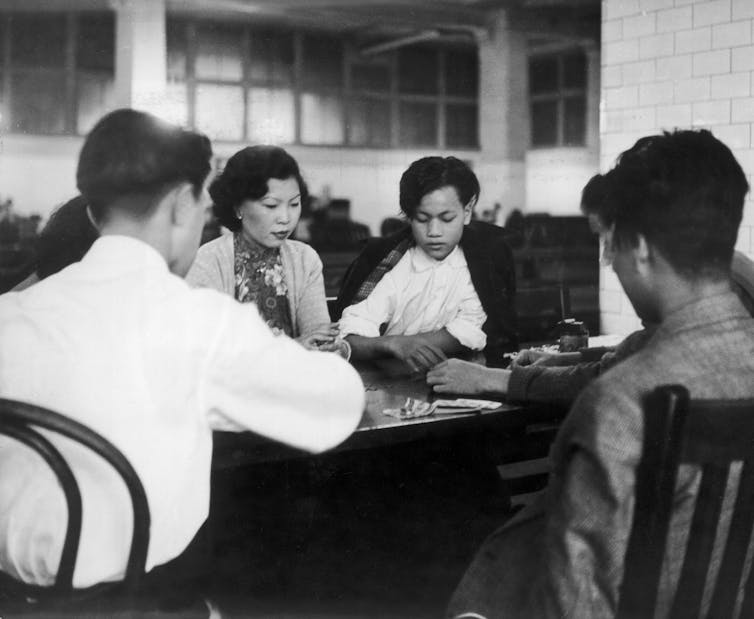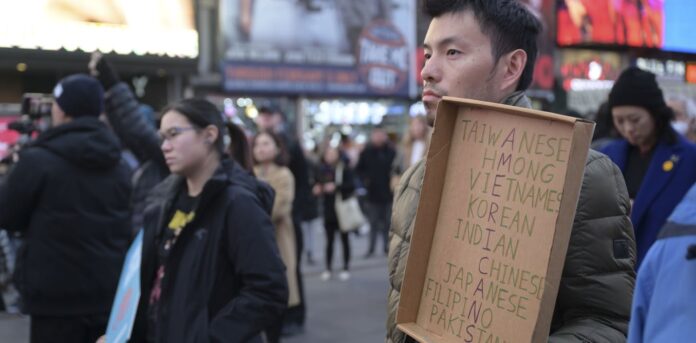For the first time, in 1990, May was officially designated as a month honoring Asian American and Pacific Islander heritage. Though the current U.S. administration recently withdrew federal recognition, the month continues to be celebrated by a wide array of people from diverse cultural backgrounds.
People from the Pacific Islands have their own distinct histories and issues, delineated in part by a specific geography. Yet when we refer to the even broader category of Asian Americans, a concept with a deep yet often unknown history, who exactly are we referring to?
There are nearly 25 million people of Asian descent who live in the United States, but the term Asian American remains shrouded by cultural misunderstanding and contested as a term among Asians themselves.
As a professor of Asian American studies, I believe it is important to understand how the label came into being.
A long history of Asian people in America
The arrival of people from Asia to the U.S. long predates the country’s founding in 1776.
After visits to modern-day America that began in the late 16th century, Filipino sailors formed – as early as 1763 – what is believed to be the first Asian settlement in St. Malo, Louisiana.
But it wasn’t until the 1849 California Gold Rush that Asian immigration to the U.S. – from China – began on a mass scale. That was bolstered in the 1860s by Chinese laborers recruited to build the western portion of the Transcontinental Railroad.
Starting toward the end of the 19th century, Japanese immigration steadily picked up, so that by 1910 the U.S. Census records a similar number for both communities – just over 70,000. Likewise, a small number of South Asian immigrants began arriving in the early 1900s.
An exclusionary backlash
Yet after coming to the U.S. in search of economic and political opportunities, Asian laborers in America were met by a surge of white nativist hostility and violence. That reaction was codified in civil society groups and government laws, such as the Chinese Exclusion Act in 1882.
By 1924, federal law had expanded into a virtual ban on all Asian immigration, and through the first half of the 20th century, a multitude of anti-Asian laws targeted areas including naturalization, marriage and housing, among others.
Bettmann/Contributor via Getty Images
From the start, people from Asian countries in the U.S. were generally identified broadly with identifiers such as “Oriental,” a common term at the time mostly for those from China, Japan and Korea.
As more Asians came to the U.S, other terms were used to denigrate and demean these new immigrants, whose physical appearance, language and cultural norms were distinctly different from their Euro-American neighbors.
‘Asian American’ and the birth of a movement
The desire to claim America was one of the drivers for activists in the 1960s to create the concept of Asian American that we know today.
The movement began in the charged political context of anti-Vietnam War protests and the Civil Rights Movement for Black equality. Students of Asian heritage at San Francisco State University and the University of California, Berkeley were organizing for the establishment of ethnic studies classes, specifically those that centered on the histories of Asians in the U.S.
Rejecting the term “oriental” as too limiting and exotic, since oriental literally means “from the East,” the student activists wanted a term of empowerment that would include the Filipino, Chinese, Korean and Japanese students at the heart of this organizing. Graduate students Emma Gee and Yuji Ichioka came up with “Asian American” as a way to bring activists under one radical organizing umbrella, forming the Asian American Political Alliance in 1968.
A contested term
Today, the Asian American label has moved beyond its activist roots. The term might literally refer to anyone who traces their lineage from the whole of the Asian continent. This could include people from South Asian countries such as India, Pakistan or Sri Lanka to parts of West Asia like Syria, Lebanon or Iran.
Yet not all people who identify as Asian actually use the words Asian American, since it is a term that flattens ethnic specificity and lumps together people with as disparate of backgrounds as Hmong or Bangladeshi, for example.
A 2023 Pew Research Center survey of self-identified Asian adults living in the U.S. revealed that only 16% of people polled said they identified as “Asian American,” with a majority – 52% – preferring ethnic Asian labels, either alone or in tandem with “American.”

Keystone-France/Gamma-Keystone via Getty Images
Moreover, unlike the student activists who worked together through their shared Asian American identity, the majority of people of Asian descent living in the U.S. came after the 1965 Immigration Act was passed, which ended all prior anti-Asian immigration laws. This, combined with a subsequent wave of Asian immigration from parts of Asia not represented in the past – including Vietnam, Taiwan and Pakistan – means that most Asian Americans alive today are either immigrants or one generation removed from immigrants.
As a largely immigrant and recently Americanized group, many Asians therefore may not relate to the struggles of an earlier history of Asians in the U.S. That may contribute to why many don’t connect with the term “Asian American.” Korean immigrants, for instance, may not see their history connected with third-generation Japanese Americans, particularly when considering their homelands have been in conflict for decades.
For some, Asian American is too broad a term to capture the complexity of Asian-heritage Americans.
Indeed, Asian Americans come from over 30 countries with different languages, diverse cultures, and histories that have often been in conflict with other Asian nations. Within such a broad grouping as “Asian American,” a wide range of political, socioeconomic, religious and other differences emerge that greatly complicate this racial label.
Even though the term remains contested, many Asians still see value in the concept. Much like the activists who first created the label in the 1960s, many believe it signifies a sense of solidarity and community among people who – despite their many differences – have been treated like outsiders to the American experience, regardless of how American their roots are.

